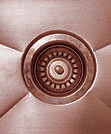
Each copper sink company has their way of addressing the copper patina process, and how it affects the product. This article will give you a better understanding of copper sink finishes, and help you make a more educated decision when making a purchase.
Let’s start with a background on copper, and what you can expect. When raw copper comes in contact with the elements, a protective coating known as patina accumulates on the surface. This patina will begin as dark brown, and as time goes on, harsher substances such as salt and vinegar will bring out brighter colors.
When first developing our line of copper sinks, we decided to do a little experiment. We had multiple sheets of raw copper and individual sinks that we manufacture. Each day, we would brush one sink with water, one with salt water, and one with a mixture of typical food waste. After about a month, the water mixture would turn the copper a dark bronze color. The salt mixture brought out reds and greens, and the food waste brought out a reddish bronze color.
We then started running experiments on cleaning the sinks. If we used a Scotch-Brite pad, and lightly scrubbed the surface patina that had formed it would bring the copper back to its natural state. Since keeping the copper bright was too difficult, we found that washing the sink occasionally with a Scotch-Brite pad, (depending on how bright you prefer) allowed us to control the color of the copper quite quickly. If green or red colors showed up, we could scrub them off and knew that another round of patina was only a matter of time.
That is the process we used for our Modern kitchen sinks. These sinks showcase the raw copper state of the sink and the natural patina you can achieve and control using this process.
Another process for copper sink manufacturing is what we call our Rustic line. This process was exhibited to us when we traveled to the Santa Clara del Cobre Valley in Mexico. Starting with recycled copper sheets, coppersmiths hammer the metal. After this, a long process of heating over an open flame, along with more hammering until the copper has an artistic blend of rustic browns and reds along the surface.
Once complete, the artisans use a natural wax and oil mixture as a finish that helps maintain the consistency and longevity of the patina. We recommend this finish on copper sinks, and our research has found that surface scratches quickly patina and are not noticeable.
Sealcoat finish copper sinks are standard as well. Use this process when you want to lock in a distinct patina (color). Create the patina by using a combination of natural elements and high temperatures. Once complete, apply a lacquer to the sink. That is an excellent way to lock in patina and prevent further color changes from accruing due to contact.
We ran seal coating tests on copper and found that it is very effective when used on products like range hoods, but we do not recommend it with copper kitchen sinks. When a scratch occurs on a seal coat finish, initially it will be bright, (it is just scratching the thin patina and seal coat surface) this scratch then patinas naturally since it lacks sealant. What you are left with is a noticeable scratch which will continue to change color over time, and a sink that will not. If you have a scratch on sealed copper sink, we recommend waiting until the patina is about the same color as the rest of the sink, then applying wax or a sealant over to keep the color consistent.
